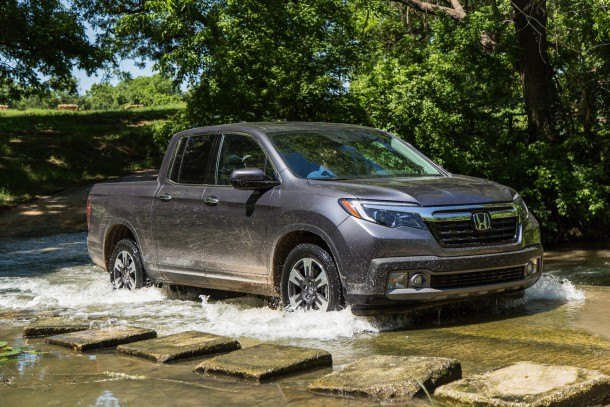Honda Is Already Selling Ridgelines Like It's 2008
American Honda reported 2,472 sales of its all-new, second-generation Ridgeline pickup in June 2016, the truck’s first month of rather limited availability.
June was the Ridgeline’s first four-digit sales month since August 2014, the Ridgeline’s first month above the 2,000-unit mark since October 2008, and the best Ridgeline sales month since August 2008.
In fact, if American Honda simply maintained the June 2016 sales pace for the rest of the year, total 2016 calendar year Ridgeline sales would essentially match 2013’s total for an eight-year high in U.S. Ridgeline sales.
Indeed, on an annualized rate, based simply on the Ridgeline’s first month back from a long hiatus, Honda is already selling more Ridgelines than at any point since 2008.
Honda will soon be able to sell more Ridgelines. And the truck deserves to sell with far greater frequency than it will. “It’s absolutely phenomenal,” TTAC’s managing editor, Mark Stevenson, wrote after a San Antonio test drive. “The interior of the Ridgeline is vast,” he said. Torque vectoring, Mark wrote, is, “a freak-of-nature feature in the pickup truck segment that gives the unibody truck an unfair advantage when it comes to handling.”
But there are two key factors which will limit Ridgeline volume. First, Honda’s own production limitations. Second, though there’s a bed on the back, the Ridgeline is a unibody vehicle turned into a pickup truck, not a conventional body-on-frame truck like every other pickup on sale in the United States.
PRODUCTION
Ridgeline sales maxed out at 50,193 units in 2006, the first-generation’s first full year. Honda would like to get back to that level, which would require adding to June’s volume by approximately 70 percent.
Based on the brief sampling period of June, it doesn’t appear as though the Ridgeline will eat into the continued growth achieved by traditional small/midsize pickup trucks.
ALTERNATIVES
Including the Ridgeline, sales of non-full-size pickups shot up 32 percent, a gain of 9,401 units versus the full-size sector’s 10-percent improvement, an increase of 16,466 sales powered largely by the Ford F-Series. The midsize sub-segment’s market share grew to 17.3 percent from 14.8 percent a year ago thanks to the addition of the Ridgeline, a 37-percent jump from the GM twins and an 84-percent Nissan Frontier uptick; despite flat Tacoma sales.
The Ridgeline is selling like it’s 2008, surging well beyond the post-recession “achievements” of Honda’s first-gen pickup. But it remains and will likely remain a relative bit player in the pickup truck arena. Only 6.4 percent of the midsize pickups and 1.1 percent of all pickup trucks sold in June 2016 were Hondas. Even if Honda managed to climb back to its best-ever sales pace, don’t expect the Ridgeline’s share to rise above 2 percent.
For Honda, if the Ridgeline doesn’t crumble after rising to such a level, that will be enough.
[Images: © 2016 Mark Stevenson and Timothy Cain/The Truth About Cars, Toyota]
Timothy Cain is the founder of GoodCarBadCar.net, which obsesses over the free and frequent publication of U.S. and Canadian auto sales figures. Follow on Twitter @goodcarbadcar and on Facebook.
More by Timothy Cain
Latest Car Reviews
Read moreLatest Product Reviews
Read moreRecent Comments
- MaintenanceCosts The Supercharger network is something with much more growth potential than their actual car building operations, which has been marvelously run to this point and has a years-long head start on all its competitors, and Elon lays the whole team off?I don't know if it's distraction or the drugs, but he is not making good decisions and should not be CEO anymore.
- Dirk Wiggler I drive down the Palisades and near the George Washington Bridge I see FIAT housing complex (apartments, same font as the auto company). Seems like they tout energy/electric efficiency. I always wonder, 'what's that...is it really the same FIAT?'
- The Oracle Massive job cuts at their state-funded facility in Buffalo. Tesla is quick to throw resources at programs to get them launched, and quick to contract when the models are in serial production:
- Cprescott Golf carts were so 1900 and so 2020. Everyone who wants one has one and is trading them in for hybrids.
- Cprescott If it were Honduh or Toyoduh's I would set it on fire.




































Comments
Join the conversation
Glad to see this doing well. I hate the way most other trucks look - their exaggerated toughness screams compensation, especially when you see they aren't actually being used to haul anything. I really appreciate the subdued, normal look of this one. It's an honest get things done utility vehicle. If I needed more towing capabilities than a minivan or the cargo characteristics of a bed, I'd look here first.
Honda should run a jump-the-shark ad where a Sierra or F-150 is dumped into its bed, rather than just stones.